정상 대변 Normal stool
정상 대변 Normal stool
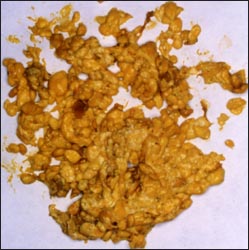
사진 27. 신생아가 모유만 먹을 때 본 순 모유 변.
Copyright ⓒ 2011 John Sangwon Lee, MD., FAAP

사진 26. 태변이 모유 변으로 변화되고 있다.
Copyright ⓒ 2011 John Sangwon Lee, MD., FAAP
- 출생하기 전 태아에게 생긴 배안 대변을 태변이라 한다.
- 태아가 자궁에서 태변을 비정상적으로 볼 수 있다.
- 분만 중 산도 속 태어나는 아기에게 산소 결핍증이 생기거나 다른 이유로 태어나는 아기가 질식될 때 자궁 속이나 산도 속에서 태변을 볼 수 있다.
- 태어난 이후 생우 2~3일 동안 태변을 보는 것은 정상이다.
- 생후 신생아가 모유나 인공영양을 먹기 시작한 이후 생후 1~2일 동안 태변이 모유를 먹는 모유 변으로 또는 인공영양을 먹는 인공영양 변으로 점차로 바꾸어 눈다. 부모도 반의사가 되어야 한다-소아가정간호 백과-제 3권 신생아, 영유아, 학령기와 사춘기 아이들의 성장발육-신생아 대변 참조.
- 생후 1~3일 동안 본 태변은 검푸르고 끈적끈적하다.
- 신생아에 따라 태변을 보는 횟수와 양도 다르다.
- 출생 첫 날에는 1~6회 정도 태변을 보는 것이 보통이다.
- 건강한 신생아들의 일부는 출생 후 24~72시간 동안 태변을 조금도 보지 않을 수 있다.
- 분만 중 태아가 어떤 이상으로 스트레스를 받거나 산소 결핍증이 태아에게 생기거나 모체에 어떤 이상이 생길 때는 태아가 자궁 내 양수 속에 태변을 눌 수 있고,
- 그 양수 속에 섞여있는 태변이 기도 속으로 흡인될 수 있고,
- 태변이 섞인 양수가 분만 중 산도 밖으로 흘러나올 수 있다.
- 드물지만, 갓 태어난 아기의 소장관이 태아 자신의 굳은 태변으로 차단될 때도 있다. 이것을 태변 소장폐색증 이라고 한다. 부모도 반의사가 되어야 한다-소아가정간호 백과-제 6권 신생아 성장 발육 질환-태변 흡인성 폐렴 참조.
모유를 먹는 신생아들이나 영아들의 대변 Breastfed newborn infant stool or infant stool
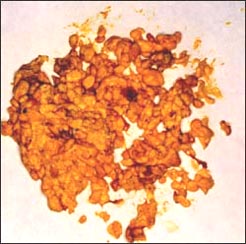
사진 29. 모유를 먹는 신생아들이나 영아들의 정상 모유변. 대변의 형태와 색이 그때그때 정상적으로 다소 변할 수 있다.
Copyright ⓒ 2011 John Sangwon Lee, MD., FAAP
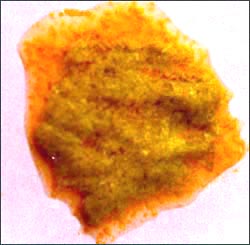
사진 28. 모유를 먹는 신생아들이나 영아들의 정상 모유 변. 대변의 형태와 색이 그때그때 정상적으로 다소 변할 수 있다.
Copyright ⓒ 2011 John Sangwon Lee, MD., FAAP
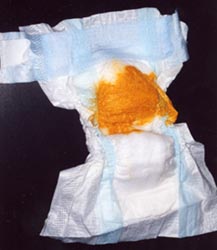
사진 31. 모유를 먹는 신생아들이나 영아들의 정상 변
대변의 형태와 색이 그때그때 정상적으로 다소 변할 수 있다.
Copyright ⓒ 2011 John Sangwon Lee, MD., FAAP
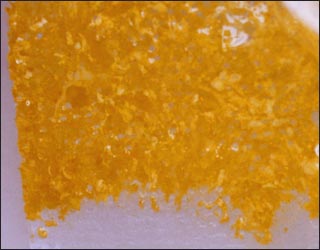
사진 30. 모유를 먹는 신생아들이나 영아들의 정상 변
대변의 형태와 색이 그때그때 정상적으로 다소 변할 수 있다.
Copyright ⓒ 2011 John Sangwon Lee, MD., FAAP
- 모유만 먹는 신생아들의 대부분은 출생 후 1~3일 동안 순 태변을 몇 번 정도 보는 것이 보통이다.
- 그 다음 생후 1~ 2일 동안 태변과 모유변이 섞인 태변 모유 혼합 변을 본다.
- 그 이후부터는 순 모유 변만 보는 것이 정상적이다.
- 이와 같이 모유만 먹는 신생아들의 대변을 모유 변이라고 한다.
- 모유만 먹는 영아들의 변의 형태와 색이 다양하다.
- 그렇지만 일반적으로 모유 변 색은 금빛같이 노랗고 설사 변 같이 묽다.
- 또 노란 고추씨 덩어리와 비슷하게 망울져 있을 수 있다.
- 젖을 충분히 먹는 신생아들의 대부분은 젖을 먹을 때마다 젖을 먹은 후 바로 대변을 보기도 한다.
- 모유만 먹는 어떤 영아들은 2~3일마다 대변을 정상적으로 한두 번 보기도 한다.
- 때로는 5일에 한 번씩 정상적으로 보기도 한다.
- 아무 증상이 없이 이렇게 4~5일 동안 대변을 보지 않는 것도 정상이다.
- 신생아나 생후 3, 4개월까지 영아들이 1일 1~7회 대변을 보기도 한다.
- 영아기의 대부분의 영아들은 1일 2~3회 정도 대변을 보는 것이 보통이다.
- 일반적으로 모유만 먹는 신생아들이나 영아들은 정상적으로 설사 변처럼 묽게 대변을 본다.
- 드물게 약간 변비 변을 볼 수 있다.
- 영아산통이 있는 영아들이 대변을 볼 때마다 심하게 울며 배에 힘을 더 많이 주고 얼굴을 붉히기도 한다. 어떤 수유모는 영아산통으로 우는 영아가 변비증으로 우는 줄로 잘못 알고 걱정하기도 한다. 그렇지만 영아가 본 대변이 정상이면 영아에게 변비증이 있다고 걱정할 필요가 없다.
- 영아가 3, 4일 만에 대변을 보더라도 대변이 딱딱하지 않고, 또 그 영아가 건강하게 정상적으로 체중이 늘고 성장 발육하면 변비가 있는 것이 아니다.
- 모유만 먹는 영아들에게 생후 4~6개월경부터 모유 이 외 인공영양 및, 또는 곡분류 이유식, 쌀 곡분류 이유식을 먹이기 시작하면 영아들의 대변의 색, 냄새, 형태, 양, 배변 횟수 등에 변화가 생긴다.
- 이유식을 먹으면서, 대변보는 횟수·색·냄새 등은 먹는 이유식의 종류와 영아의 나이에 따라 다르다.
- 대부분의 영유아들이 2살이 될 때부터 그들의 대변은 성인들의 대변의 형태, 냄새 등과 거의 비슷해진다.
인공영양을 먹는 신생아들 또는 영아들의 대변 Formula-fed newborn infant stool or Formula-fed baby’s bowel movements
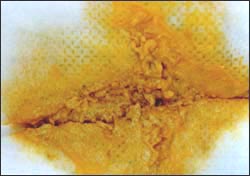
사진 32. 인공영양을 먹는 영아들의 변
모유를 먹는 영아들의 변과 비슷한 변을 볼 때가 많다.
인공영양의 종류에 따라 변의 색이 다를 수 있다.
Copyright ⓒ 2011 John Sangwon Lee, MD., FAAP
- 우유 단백질이나 콩 단백질 또는 그 외 다른 종류의 단백질과 탄수화물·지방질·미네랄·비타민·물 등으로 모유 대신 신생아들이나 영아들이 먹을 수 있게 조제한 음식물을 포물라(Infant formula) 또는 인공영양이라고 한다.
- 포물라를 분유라고 부르기도 하지만 분유에는 가루형태로 된 순 우유 분유도 있고 가루형태로 된 포물라도 있기 때문에 분유라고 부르면 혼동이 생긴다.
- 인공영양을 먹는 신생아들과 영아들의 대변의 색과 형태는 그들의 나이와 먹는 인공영양의 종류 등에 따라 다르다.
- 우유 단백질이나 콩 단백질의 성분으로 만든 인공영양만 먹는 신생아들이나 영아들의 대변의 색은 모유만 먹는 신생아들, 영아들의 대변의 색과 거의 같은 연한 노란색이든지 연한 갈색 또는 황갈색이다.
- 때로는 모유 변과 인공영양 변을 확실히 구별할 수 없다.
- 모유만 먹는 신생아, 영아의 대변과 거의 비슷하게 물같이 묽게 누는 것이 보통이지만, 인공영양을 먹는 신생아, 영아의 대변은 모유만 먹는 신생아, 영아의 대변보다 좀 더 된 편이다.
- 그러나 항상 그렇지는 않다.
- 모유만 먹는 신생아, 영아의 대변은 냄새가 거의 나지 않지만, 인공영양만 먹는 신생아, 영아의 대변은 냄새가 좀 더 난다.
- 인공영양만 먹던 영아가 인공영양과 이유식을 같이 먹기 시작하면 대변 냄새가 성인의 것과 거의 비슷하다.
- 이 때 대부분의 영아들은 하루에 정상적으로 1~2회 정도 대변을 보지만 정상적으로 3, 4일마다 한두 번 대변을 보는 영아들도 가끔 있다.
- 인공영양의 종류와 양, 이유식의 종류와 양, 영아들의 감정의 변화, 주위 환경 변화 등에 따라 대변의 색과 묽기 등이 그때그때 조금씩 변할 수 있다.
- 여아들이 가끔 푸른색 대변 또는 점액이 소량 섞인 대변을 가끔 보는 것도 정상일 수 있다. 그러나 계속 보면 정상이 아니다.
- 인공영양과 이유식을 함께 먹을 때부터는 대변의 색·양·냄새·횟수가 이유식의 종류에 따라 많이 달라지기 시작한다.
- 뉴트라미젠이란 인공영양을 먹는 신생아들이나 영아들의 대변은 정상적으로 설사 변과 같이 묽고 색이 푸르스름한 것이 보통이다.
첫돌 이후 유아들이나 학령기 아이들의 정상 대변 Normal stool of toddler, Preschool children, Schoolchildren

사진 33. 때로는 정상적으로 좀 질게 본다.
Copyright ⓒ 2011 John Sangwon Lee, MD., FAAP
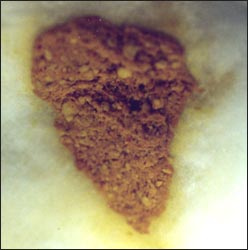
사진 34. 때로는 정상적으로 좀 질게 본다.
Copyright ⓒ 2011 John Sangwon Lee, MD., FAAP
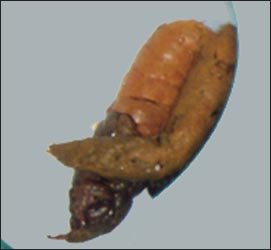
사진 35. 때로는 정상적으로 좀 더 되게 본다.
Copyright ⓒ 2011 John Sangwon Lee, MD., FAAP
- 첫 돌 이후 유아들이나 학령기 아이들의 대변의 색, 양, 경도, 냄새 등은 먹는 음식물의 종류, 육체적 활동, 또는 위장 내 상주 세균주 등에 따라 정상적으로 조금씩 변할 수 있다.
- 대변의 경도가 정상적으로 죽처럼 걸쭉하거나, 설사 변 같이 묽거나, 때로는 좀 단단한 것이 보통이다.
- 대변의 색은 정상적으로 누르스름하거나 노랗거나 회색인 것이 보통이다.
- 금방 본 대변은 변기 물속에 가라앉는 것이 일반적이다. 그러나 위장 흡수장애가 있는 위장병이 있는 유아나 학령기 아이가 금방 본 대변은 변기 물속에 가라앉지 않고 뜨는 것이 보통이다.
- 대변의 냄새는 먹은 음식물의 종류에 따라 다를 수 있다.
- 정상이 아닌 변에서 고약한 냄새가 나는 것이 보통이다.
- 생후 2세 이후부터 대부분의 유아들은 성인들이 누는 대변과 거의 비슷한 대변을 보는 것이 보통이다.
Normal stool

Photo 27. Pure breast milk stools seen when a newborn is breastfed only. Copyright ⓒ 2011 John Sangwon Lee, MD., FAAP

Photo 26. Meconium is changing into breast milk. Copyright ⓒ 2011 John Sangwon Lee, MD., FAAP
• Abdominal feces produced by the fetus before birth is called meconium.
• The fetus may have an abnormal meconium in the womb.
• You may have meconium in the womb or in the birth canal when a baby born in the birth canal during labor develops oxygen starvation or is choking for other reasons.
• It is normal for live cows to have meconium for 2-3 days after birth.
• After a newborn baby starts to eat breast milk or artificial nutrition, for 1 to 2 days after birth, the meconium changes gradually to breast milk or artificial nutrition. Parents Should Be Anti-Doctors—See Encyclopedia of Pediatric and Family Nursing—Vol. 3 Growth and Development of Newborns, Infants, School-Ages and Adolescents—Newborn Stools.
• Meconium seen during the first to third days after birth is dark blue and sticky.
• The number and amount of meconium varies depending on the newborn. • It is normal to have 1 to 6 meconiums on the first day of birth.
• Some healthy newborns may not have any meconium for 24 to 72 hours after birth.
• During labor, when the fetus is stressed, oxygen deficiency develops in the fetus, or in the mother’s body, the fetus may press meconium into the amniotic fluid in the uterus;
• Meconium mixed in the amniotic fluid can be aspirated into the airways,
• Amniotic fluid mixed with meconium may flow out of the birth canal during labor.
• In rare cases, the small intestine of a newborn baby is blocked by the fetus’s own hard meconium. This is called meconium small bowel obstruction. www.drleepediatrics.com—Vol. 6 Neonatal Growth and Development Disorders—Meconium aspiration pneumonia.
Breastfed newborn infant stool or infant stool

Picture 29. Normal milk stools in breastfed newborns or infants. The shape and color of stool may change slightly from time to time. Copyright ⓒ 2011 John Sangwon Lee, MD., FAAP

Picture 28. Normal milk stools in breastfed newborns or infants. The shape and color of stool may change slightly from time to time. Copyright ⓒ 2011 John Sangwon Lee, MD., FAAP

Picture 31. Normal stools in breastfed newborns or infants The shape and color of stool may change slightly from time to time. Copyright ⓒ 2011 John Sangwon Lee, MD., FAAP

Photo 30. Normal stools in breastfed newborns or infants The shape and color of stool may change slightly from time to time. Copyright ⓒ 2011 John Sangwon Lee, MD., FAAP
• It is normal for most breastfed newborns to have a few pure meconiums in the first 1-3 days after birth.
• Then have meconium milk mixed stool with meconium and breast milk for 1 to 2 days after birth.
• From then on, it is normal to see only pure breast milk stools.
• The stools of newborns who only feed on breast milk are called breast milk stools.
• The shape and color of stools in breastfed infants vary.
• However, breast milk discoloration is usually golden yellow and watery like diarrheal stools.
• It can also be lumpy similar to a lump of yellow pepper seeds.
• Most breastfed newborns will defecate immediately after feeding each time they are breastfed.
• Some breastfed infants have a normal bowel movement once or twice every two to three days.
• Sometimes I see it normally once every 5 days.
• It’s normal to not have a bowel movement for 4-5 days like this without any symptoms.
• Newborns and infants up to 3 or 4 months of age may have 1 to 7 bowel movements per day.
• It is normal for most infants in infancy to have a bowel movement 2-3 times a day. • Newborns and infants who are normally only breastfed usually have loose stools, such as diarrheal stools.
• Rarely, you may have slightly constipated stools.
• Infants with colic may cry violently every time they have a bowel movement, increase their abdominal strength and may even blush. Some nursing mothers mistakenly believe that an infant crying for colic is crying because of constipation. However, if the stool the infant sees is normal, there is no need to worry about the infant being constipated. • Even if an infant has a bowel movement in 3 or 4 days, if the stool is not hard and the infant gains weight and grows and develops healthy, it is not constipated.
• Changes in the color, odor, shape, amount, frequency of bowel movements, etc. of infants’ feces when they start feeding infants who are breastfed only with artificial nutrition other than breast milk, or grain-based baby food or rice grain-sorted baby food from around 4 to 6 months of age. occurs
• While eating baby food, the frequency, color, and smell of bowel movements vary depending on the type of food eaten and the age of the infant.
• By the time most infants are 2 years old, their stools become almost identical in shape and smell to those of adults.
Formula-fed newborn infant stool or Formula-fed baby’s bowel movements

Photo 32. Stools of infants fed artificial nutrition Breastfed infants often have stools similar to those of infants. The color of the stool may vary depending on the type of artificial nutrition. Copyright ⓒ 2011 John Sangwon Lee, MD., FAAP
• Milk protein, soy protein, or other types of protein and carbohydrates, fats, minerals, vitamins, water, etc., prepared for use by newborns or infants instead of breast milk is called Infant formula or artificial nutrition.
• Formulas are sometimes called powdered milk, but there are some pure milk powders in powder form and some in powdered form, so calling it powdered milk causes confusion. • The color and shape of the stools of newborns and infants fed artificial nutrition depend on their age and the type of artificial nutrition they eat.
• The color of the stool of newborns or infants fed only artificial nutrition made with milk protein or soy protein is a pale yellow, light brown or tan color that is almost the same color as that of breastfed newborns and infants.
• Sometimes it is not possible to clearly distinguish between breast milk and artificial nutrition.
• Although it is common for newborns who only breastfed and infants to pass their stools as thin as water, the stools of newborns and infants fed artificial nutrition tend to be slightly thicker than those of newborns and infants who are fed only breast milk.
• But not always.
• The feces of newborns and infants who are only breastfed have little odor, but the feces of newborns and infants who are fed only artificial nutrition do have a more odor. • When an infant who was fed only artificial nutrition starts eating artificial nutrition and baby food together, the smell of feces is almost identical to that of an adult.
• At this time, most infants have a normal bowel movement 1 to 2 times a day, but there are some infants who normally have a bowel movement once or twice every 3 or 4 days.
• Depending on the type and amount of artificial nutrition, the type and amount of baby food, changes in infants’ emotions, and changes in the surrounding environment, stool color and thinness may change little by little.
• It may be normal for girls to occasionally have blue stools or small amounts of mucus. But if you keep looking, it’s not normal.
• When you start eating artificial nutrition and baby food together, the color, quantity, smell, and frequency of stool start to change a lot depending on the type of baby food.
• The stool of newborns or infants who are given artificial nutrition called Neutramigen is normally watery and bluish in color, similar to diarrhea stool.
Normal stool of toddler, Preschool children, Schoolchildren

Photo 33. Sometimes it looks a little bit tired normally. Copyright ⓒ 2011 John Sangwon Lee, MD., FAAP

Photo 34. Sometimes it looks a little stinky normally. Copyright ⓒ 2011 John Sangwon Lee, MD., FAAP

Photo 35. Sometimes I look a little more normal. Copyright ⓒ 2011 John Sangwon Lee, MD., FAAP
• The color, quantity, hardness, and smell of the stool of infants or school-age children after the first birthday may change slightly depending on the type of food eaten, physical activity, or resident bacterial strain in the stomach.
• The stool is normally thick like porridge, watery like diarrheal stool, and sometimes hard. • The color of the stool is normally yellow, yellow, or gray.
• It is common for freshly seen stool to sink into the toilet bowl. However, it is common for infants or school-age children with gastrointestinal diseases with gastrointestinal malabsorption to float rather than sink in the toilet water.
• The smell of feces may differ depending on the type of food eaten. • It is normal for the stool to have a foul odor that is not normal.
• After 2 years of age, most infants have stools that are similar to those of adults.
출처 및 참조 문헌
- www.drleepediatrics.com 제1권 소아청소년 응급 의료
- www.drleepediatrics.com 제2권 소아청소년 예방
- www.drleepediatrics.com 제3권 소아청소년 성장 발육 육아
- www.drleepediatrics.com 제4권 모유,모유수유, 이유
- www.drleepediatrics.com 제5권 인공영양, 우유, 이유식, 비타민, 미네랄, 단백질, 탄수화물, 지방
- www.drleepediatrics.com 제6권 신생아 성장 발육 육아 질병
- www.drleepediatrics.com제7권 소아청소년 감염병
- www.drleepediatrics.com제8권 소아청소년 호흡기 질환
- www.drleepediatrics.com제9권 소아청소년 소화기 질환
- www.drleepediatrics.com제10권. 소아청소년 신장 비뇨 생식기 질환
- www.drleepediatrics.com제11권. 소아청소년 심장 혈관계 질환
- www.drleepediatrics.com제12권. 소아청소년 신경 정신 질환, 행동 수면 문제
- www.drleepediatrics.com제13권. 소아청소년 혈액, 림프, 종양 질환
- www.drleepediatrics.com제14권. 소아청소년 내분비, 유전, 염색체, 대사, 희귀병
- www.drleepediatrics.com제15권. 소아청소년 알레르기, 자가 면역질환
- www.drleepediatrics.com제16권. 소아청소년 정형외과 질환
- www.drleepediatrics.com제17권. 소아청소년 피부 질환
- www.drleepediatrics.com제18권. 소아청소년 이비인후(귀 코 인두 후두) 질환
- www.drleepediatrics.com제19권. 소아청소년 안과 (눈)질환
- www.drleepediatrics.com 제20권 소아청소년 이 (치아)질환
- www.drleepediatrics.com 제21권 소아청소년 가정 학교 간호
- www.drleepediatrics.com 제22권 아들 딸 이렇게 사랑해 키우세요
- www.drleepediatrics.com 제23권 사춘기 아이들의 성장 발육 질병
- www.drleepediatrics.com 제24권 소아청소년 성교육
- www.drleepediatrics.com 제25권 임신, 분만, 출산, 신생아 돌보기
- Red book 29th-31st edition 2021
- Nelson Text Book of Pediatrics 19th- 21st Edition
- The Johns Hopkins Hospital, The Harriet Lane Handbook, 22nd edition
- 응급환자관리 정담미디어
- Pediatric Nutritional Handbook American Academy of Pediatrics
- 소아가정간호백과–부모도 반의사가 되어야 한다, 이상원 저
- The pregnancy Bible. By Joan stone, MD. Keith Eddleman, MD
- Neonatology Jeffrey J. Pomerance, C. Joan Richardson
- Preparation for Birth. Beverly Savage and Dianna Smith
- 임신에서 신생아 돌보기까지. 이상원
- Breastfeeding. by Ruth Lawrence and Robert Lawrence
- Sources and references on Growth, Development, Cares, and Diseases of Newborn Infants
- Emergency Medical Service for Children, By Ross Lab. May 1989. p.10
- Emergency care, Harvey Grant and Robert Murray
- Emergency Care Transportation of Sick and Injured American Academy of Orthopaedic Surgeons
- Emergency Pediatrics A Guide to Ambulatory Care, Roger M. Barkin, Peter Rosen
- Quick Reference To Pediatric Emergencies, Delmer J. Pascoe, M.D., Moses Grossman, M.D. with 26 contributors
- Neonatal resuscitation Ameican academy of pediatrics
- Pediatric Nutritional Handbook American Academy of Pediatrics
- Pediatric Resuscitation Pediatric Clinics of North America, Stephen M. Schexnayder, M.D.
-
Pediatric Critical Care, Pediatric Clinics of North America, James P. Orlowski, M.D.
-
Preparation for Birth. Beverly Savage and Dianna Smith
-
Infectious disease of children, Saul Krugman, Samuel L Katz, Ann A.
- 제4권 모유, 모유수유, 이유 참조문헌 및 출처
- 제5권 인공영양, 우유, 이유, 비타민, 단백질, 지방 탄수 화물 참조문헌 및 출처
- 제6권 신생아 성장발육 양호 질병 참조문헌 및 출처
- 소아과학 대한교과서
Copyright ⓒ 2014 John Sangwon Lee, MD., FAAP
“부모도 반의사가 되어야 한다”-본 사이트의 내용은 여러분들의 의사로부터 얻은 정보와 진료를 대신할 수 없습니다.
“The information contained in this publication should not be used as a substitute for the medical care and advice of your doctor. There may be variations in treatment that your doctor may recommend based on individual facts and circumstances.
“Parental education is the best medicine.”